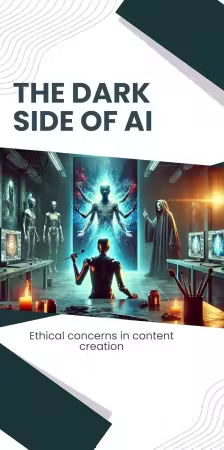
English | November 27, 2024 | ASIN: B0DP77RMB8 | 127 pages | EPUB | 11 Mb
is transforming content creation, automating tasks and generating narratives. However, it raises ethical concerns about authorship, creativity, and accountability. This book delves into the benefits and risks of AI-driven writing, addressing issues like originality, ownership, bias, transparency, and misuse. It explores the ethical boundaries shaping the future of AI in content creation.
Table Of Content- Understanding the Role of AI in Content Creation
- Defining Ethical Challenges in AI
- Purpose and Scope of the Book
Part 1: AI in Content Creation - A Double-Edged Sword
Chapter 1: The Evolution of AI in Writing
- From Rule-Based Systems to Machine Learning
- How AI Transformed Content Creation
- The Promises and Pitfalls
Chapter 2: The Mechanics of AI-Generated Content
- Natural Language Processing (NLP) and Machine Learning Basics
- Training Data and Algorithmic Foundations
- Strengths and Limitations of AI Writing Tools
Chapter 3: The Growing Dependence on AI Tools
- Why Businesses and Writers Rely on AI
- The Cost of Convenience in Content Creation
- The Impact on Human Creativity
Part 2: Ethical Dilemmas in AI Writing
Chapter 4: Authorship and Ownership
- Who Owns AI-Generated Content?
- Intellectual Property Rights in the AI Age
- Case Studies: Disputed Ownership
Chapter 5: Transparency and Accountability
- The Need to Disclose AI Involvement
- Holding AI Systems Accountable for Generated Content
- Ethical Guidelines for Responsible AI Use
Chapter 6: Bias in AI Outputs
- Understanding Bias in Training Data
- Ethical Implications of Biased Content
- Strategies for Mitigating Bias
Chapter 7: Plagiarism and Originality
- AI's Reliance on Pre-Existing Content
- The Challenges of Maintaining Originality
- Safeguarding Against Plagiarism
Chapter 8: Manipulation and Fake Content
- AI in Generating Deepfakes and Misinformation
- Ethical Concerns in AI Propaganda
- The Role of Regulation in Tackling Misinformation
Part 3: Societal Impacts , Ethical Standards
Chapter 9: The Devaluation of Human Creativity
- AI as a Replacement for Human Writers
- Economic and Cultural Implications
- The Future of Human Creativity in an AI World
Chapter 10: Accessibility vs. Exploitation
- Democratizing Content Creation Through AI
- Ethical Concerns Around Labor and Fair Compensation
- Balancing Accessibility with Fairness
Chapter 11: Privacy and Data Concerns
- How AI Uses Personal Data for Content Creation
- Ethical Issues in Data Collection and Utilization
- Protecting User Privacy in the AI Era
Part 4: Navigating the Ethical Landscape
Chapter 12: Establishing Ethical Guidelines
- Industry Standards for Ethical AI Use
- Encouraging Transparency in AI Development
- Collaboration Between Stakeholders
Chapter 13: Legal and Regulatory Approaches
- The Role of Governments and Lawmakers
- Intellectual Property Laws and AI
- Policies to Ensure Accountability
Chapter 14: Best Practices for Responsible AI Content Creation
- Ethical Practices for Writers and Organizations
- Tools and Techniques to Mitigate Ethical Risks
- Promoting Awareness and Education
Conclusion- Reflecting on the Ethical Challenges in AI Content Creation
- Striking a Balance Between Innovation and Responsibility
- Shaping the Future of AI in Content Creation